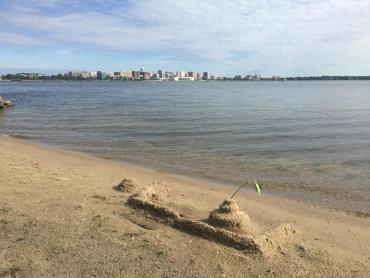Public Health Works to Keep Swimming Water Safe
No one wants a day at the beach to make them sick. During the summer months, Public Health Madison & Dane County (PHMDC) Sanitarians and Laboratory staff check water quality at many public area beaches to make sure the water is healthy to swim and play in.
Between Memorial Day and Labor Day the PHMDC Laboratory tests water at local swimming beaches for bacteria and blue-green algae to determine if they are safe for swimming and recreation, and to reduce the risk of illness.
Water is tested at the beaches weekly, and if a test shows concerning results, PHMDC will close the beach by posting signs and updating the PHMDC website. Water is then checked each weekday until levels of bacteria and blue-green algae return to acceptable levels.
Certain blue-green algae blooms produce toxins that can cause symptoms such as stomach upset, rashes, and respiratory irritation. Dogs that come into contact with algal blooms can also get sick and sometimes die because their bodies are smaller and they tend to swallow a lot of water. Both people and pets should avoid being in water where algal blooms are present.
Harmful algal blooms vary in their appearance, looking like scum, foam, or a mat, and despite their name, can be different colors. Lots of sunlight, high water temperatures and low wind levels usually cause them to grow.
Should people discover they are in the water near a bloom, it is important that they avoid swallowing water and that they rinse off well when they get out. If people have symptoms they think are due to contact with blue-green algae blooms they should call their healthcare provider or the Poison Control Center at 1-800-222-1222. Dogs that have been in water near a bloom should also be rinsed well and a vet should be called if they seem ill after.
“While we always check for blue-green algae blooms while visiting beaches for routine monitoring, conditions can change quickly and algae may appear after our visit. If you suspect there is a bloom at one of our beaches, avoid swimming and contact us at (608) 243-0357 so we can send someone out to check on the conditions at that beach,” says Jennifer Lavender-Braun, PHMDC Microbiologist.
“Once you get to the beach, always take a look at water conditions before getting into the water, especially after a heavy rainfall. That’s when stormwater runoff containing things like goose and pet waste can cause E. coli bacteria levels to be higher,” continues Lavender-Braun.
People can check to see if a beach is open before they go by checking the PHMDC website, checking the department’s Facebook and Twitter pages, or by signing up for beach condition alerts. Even if one beach is closed, others may be open.
Contacts
- Sarah Mattes, (608) 242-6414, smattes@publichealthmdc.com
